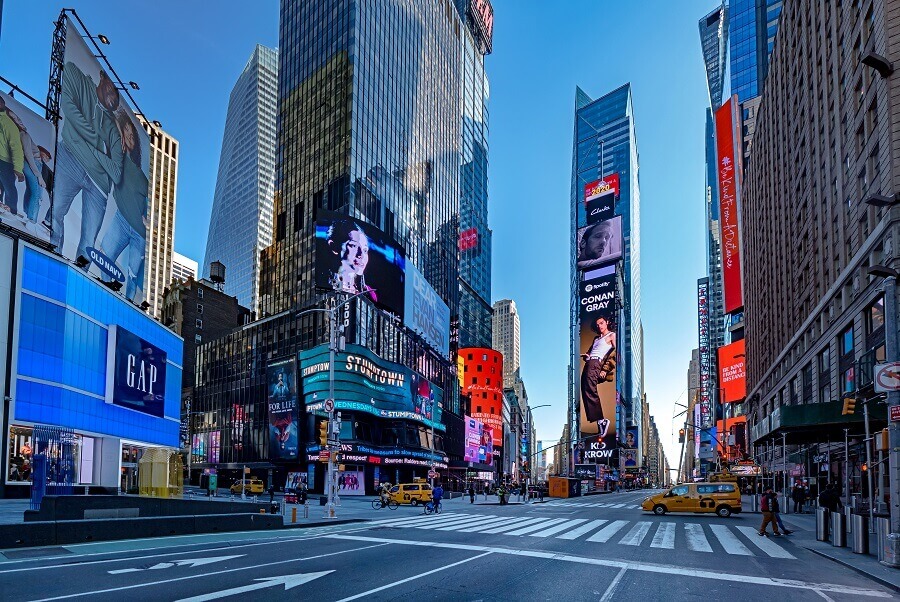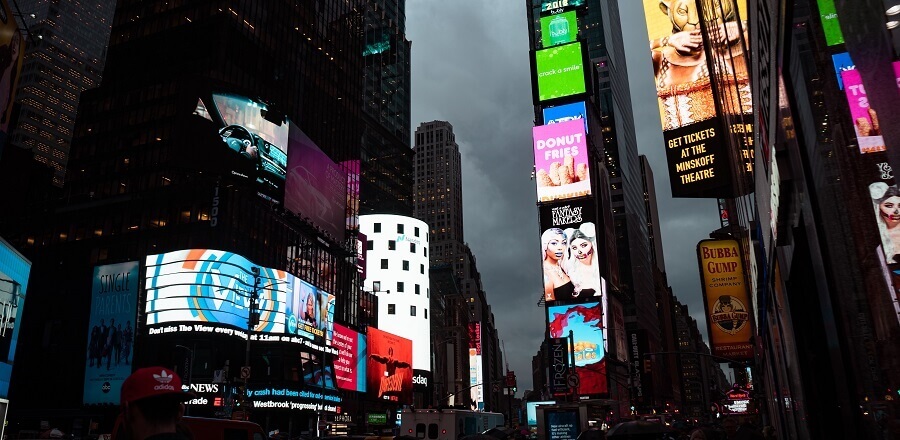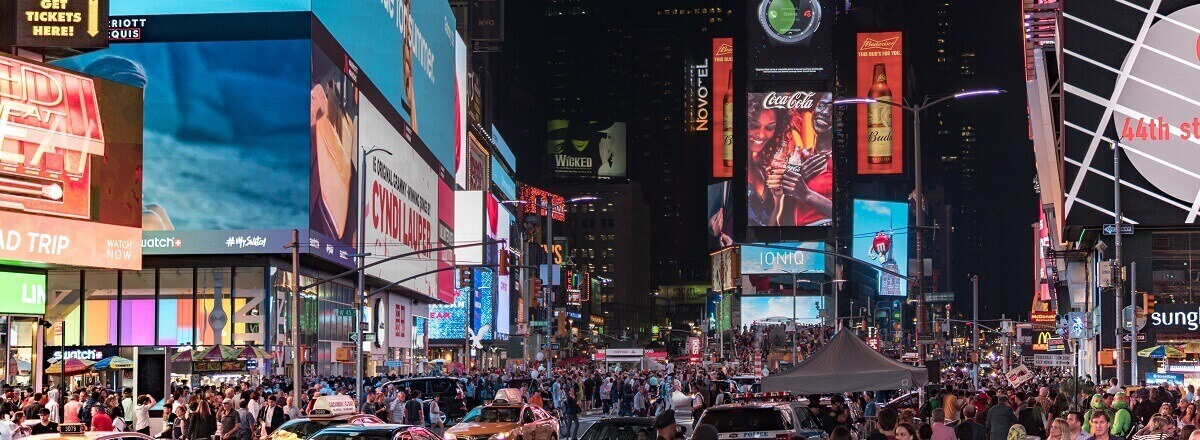| October 11, 2021
Choosing the best digital signage software: Top features to look for in 2023
The best digital signage software makes it easy to distribute and manage content across a DOOH network of any size. And with digital out-of-home ad spending expected to reach new heights in the coming months and years, the success of your business will depend on choosing software that’s capable of supporting your network’s growth.
Whether you’re looking to build or upgrade a digital signage network, your choice of software is going to play a big role in determining how well you do. To help you assess which digital signage solution is the best fit for your business, we explore some of the key features common to today’s top DOOH software.
What is digital signage software?
Before diving into specific features and functionality, you first need to understand the digital signage ecosystem. Every digital signage network requires hardware—consisting of the displays themselves and typically one quality digital signage player per screen—and software. A crucial component, the software is what pushes content to your digital signage and controls which media appears on-screen at any given time.

Digital signage software is comprised of a content management system (CMS), which allows you to easily manage and run the entire network from one central location, and a playback software that is installed on each display’s player. The CMS is the brains of the digital signage system; it’s the central platform that enables you to manage, deploy, and update content on your digital screens. Because of this, the terms “digital signage software” and “content management software” are sometimes used interchangeably. However, the capabilities and features included within a given digital signage software package will vary, and conflating the two can be misleading.
Today’s digital signage software covers a range of roles in the management of your digital signage network and includes powerful tools to optimize effectiveness and efficiency.
Top digital signage software use cases
Here are some of the ways that digital signage software can help you manage your DOOH network:
- Managing content and digital signage devices: Software that operates as a content management system (CMS) delivers control over the actual content and settings on the digital signage itself.
- Serving ads to your digital signs: If you’re selling ad space on your digital signs, ad server software can help you serve up those ads in a manageable way by directing your advertising content to the appropriate devices at the appropriate time.
- Enabling programmatic selling: A supply-side platform (SSP) makes your inventory available as a service in a more direct way to potential customers. This allows you to open your network up to targeted campaigns from around the world and generate new revenue programmatically.
- Optimizing the direct selling process: Sales tools specifically designed for OOH campaigns offer access to real-time inventory availability and rebalance campaigns to optimize yield.
Some DOOH software providers sell all-in-one integrated solutions while other offerings only cover one or some of the roles outlined above. Whatever your DOOH management goals, your digital signage software should be able to deliver maximum impact for your business.

Top 20 key features of the best digital signage software
The best digital signage software is open, helps streamline your workflow, and makes it easy to integrate the tools you need to succeed. In other words, it makes your life a whole lot easier.
Here’s a look at some of the specific features we think should go on your shopping list for digital signage and digital-out-of-home software in 2023.
Basic features for digital signage
If you’re just looking to run a good digital signage network, you may not need all the fanciest, newest features of leading digital signage platforms. At minimum, here are some of the important things we think you should look out for.
Support for important media formats
If you’re just looking to share static images on a digital display, any digital signage software should be able to handle your JPG or PNG files for you.
But if you want to display moving content, you’re going to need to make sure your software can support it. For non-dynamic video, MP4 is a standard format that most software can likely play. Note that if you want to play 4K content, you should double-check that the software supports that specifically. If you want to display dynamic content, you need to make sure your software supports HTML5 and is able to render the creative correctly.
These are just the standards. If you’re working with a format other than those listed above, be sure to check in with prospective software providers to make sure they can deliver what you need.
Example: This campaign for Oreo used video content that lined up with a solar eclipse to create a truly memorable moment.
Great platform stability
Digital signage and digital out-of-home are meant to be seen. This means that crashes, errors, and other accidents are very noticeable and very annoying, both for publishers and their customers.
For that reason, we strongly recommend making software stability one of your core concerns when evaluating your options. A good platform will have near-perfect uptime and let you focus on big-picture elements of your business, not mundane concerns of whether your software has crashed again.
Top-notch security
Hacking incidents involving digital signage can be amusing – unless it’s your displays that are the victims.
The fact is, when you have digital displays out in public spaces, there are sometimes mischief-makers or bad actors who will try to hack into them. While taking measures to physically limit the ability of these people to gain access to your systems is a great place to start, make sure that your software solution can also lock out any unauthorized individuals who manage to get into your system.
SOC I and SOC II security are considered standard for business-critical software, so be on the lookout for solutions that meet those standards.

Scalability
Some common digital signage software will work just fine for smaller networks (around 1-20 or so screens). Try to expand beyond that, though, and often the workflows become time-consuming, or the content management gets overwhelming.
Moving from one platform to another every time you outgrow a solution makes for a lot of additional work. Avoid that by selecting digital signage software that can scale up with you. The right solutions will let you manage 50, 100, or 1,000 displays with just about the same ease, meaning you won’t have to stress about growing the way you want to.
Remote monitoring + control features
It really pays to be able to run your business remotely. It’s just plain faster and easier to be able to keep track of your displays from one centralized location, and to make emergency changes or last-minute content updates from wherever you are.
If you want to succeed in DOOH in the 2020s, remote monitoring and control of DOOH assets is really a baseline requirement, so make sure your chosen DOOH software supports it.

Advanced features: Digital signage software for DOOH advertising
If you have higher ambitions for your digital signage network than just putting up content on a schedule, there are a handful of features you should make sure your digital signage platform can support. For networks looking to leverage the power of advertising, these are some advanced software features to watch out for.
Targeted ad serving
Targeted campaigns are more effective, more relevant, more economical for buyers, and can be sold at a higher relative cost for DOOH media owners. They truly do offer benefits across the board.
That’s why software selected by ambitious DOOH businesses today ought to include granular targeting capabilities allowing for specific audiences to be advertised to with out-of-home ads. The best ones make it dead simple to define audience criteria like age and location, and even incorporate other factors, such as weather conditions, financial market data, and more, to pick the perfect time to deliver the perfect message to the audience a buyer wants to connect with.
Proof-of-play reporting
If you have commitments to playing content on your digital signage, it’s important that you can see that you’re actually meeting those commitments. That’s why it’s worthwhile to invest in a platform that includes good proof-of-play reporting.
PoP reports can tell you when content was played, where it was played, how many impressions it likely got, and other kinds of information that you and any customers or partners will want to know. Prioritize this capability if you want to truly understand how content is performing on your network.
Automated content scheduling + delivery
Especially for larger networks, manually scheduling content can be a real time suck. It also leaves a lot of room for error. For instance, you might have to make sure ads for competing brands are kept separate, or accommodate advertisers’ demands not to have their ads appear in the same loop as particular products or industries. And if there’s a last minute change requested for one campaign, you might have to do a lot of work rescheduling a bunch of others to make everything fit.
With automated DOOH management software, all of this goes away. You enter the parameters under which a piece of content should be played and the system handles scheduling and delivery automatically. And if something changes, the system will take care of everything for you – no need to go back and change the entire schedule by hand.
The amount of time you save is truly life changing.

Expandability (for data feeds, other integrations)
Some of the coolest content in digital signage and digital out-of-home is created by integrating data feeds, audience analytics tools, and other capabilities that generally aren’t included in digital signage software by default.
If you want to be able to deliver great advertising, provide useful live information, or just better understand the demographic makeup of your audience, make sure your digital signage software will be able to integrate with all the tools and data you need.
Multi-screen & synchronization capabilities
One screen is great, but using multiple digital displays to present your content can make for a better, or even memorable, experience. This could mean having one piece of creative use multiple displays as a larger canvas, or have multiple screens display mirrors of the same content, all playing in sync.
You’ll need hardware that is capable of driving content to all of these displays at the same time – it takes more juice than is needed with a single display – but you’ll also need to make sure your software is up to the task. If multi-display or synchronized playback are important to you, be sure to double-check that your software can handle it.
Content caching for later delivery
Theoretically, truly live content delivery is nice – the right content arrives to the right screen at exactly the right time. In practice, however, this can lead to problems. A slow or unstable connection could lead to screens blanking, or loading content unacceptably slowly.
Remote content delivery is ideal, but only if your system supports caching the content a few minutes in advance and then playing it back at the right moment. You get to avoid connection issues messing with your content playback while still maintaining the relevance that near-live scheduling can offer
Features for better digital signage content
Digital signage and DOOH content can go well beyond the basics of scheduling images or videos on a loop. If you want to deliver more relevant, more exciting, and more timely information across your network, here are some of the features to look for.
Content targeting capabilities
Sure, you can just put up any old content in a loop and call it a day – but why settle for that? Today, it’s possible to target the content that appears on a screen so that it is a good match for the demographics that are in a given location.
Being able to understand a screen’s audience and deliver appropriate content to that audience is a baseline for modern digital signage content in 2023, so don’t settle for less.

Dynamic content playback
Dynamic content is content that changes in response to external data. The applications can include displaying different creative based on weather, traffic levels, lottery jackpot size, and just about anything else you can think of.
It’s a great way to grab audience attention, so many big buyers want to create dynamic campaigns. Trouble is, not all software is capable of displaying this type of content. Make sure your digital signage software supports dynamic playback so that you don’t miss out on great opportunities.
Support for interactivity
One of the most fun developments in digital signage in the past few years is that interactive digital signage has become more common. Touchscreen kiosks are popping up everywhere, non-touch gesture control is making inroads, and even less direct methods of interactivity, like social media and mobile device integrations, are being used to great effect.
Interactive content is great at catching the eye, and some of the most memorable campaigns of recent years have included interactivity in some capacity. If you want your network to be eligible for these kinds of campaigns, make sure you select digital signage software that will support interactive campaigns.

Managed local messaging tools
Sometimes, it’s helpful to have on-location teams update elements of the digital signage content mix directly. Maybe the hours are changing at just one branch of a larger business, or a particular item has just sold out. Empowering the local team to reflect those changes on their digital signage themselves is a great way to speed up turnaround time for important information.
Look for a managed local messaging feature to ensure your brand guidelines are adhered to when your teams are making adjustments, as well as to ensure anyone can make necessary modifications, regardless of their design ability.
Example: See how Broadsign Publish makes local messaging easy to edit and schedule for delivery
Emergency messaging features
In good times and bad, digital signage is a great way to share important messages. That’s why it can be a good idea to ensure your digital signage software includes emergency messaging capabilities.
With built-in emergency messaging, you can quickly override regular programming to share instructions for audiences, or directions to exits or other points of safety. It’s the kind of feature you hope to never have to use, but is great to have if ever you do.
Features for digital signage ad sales optimization
Not all digital signage networks rely on sales, but for those that do, it’s important to adopt intelligent tools that will empower the sales team to make great deals quickly. Here are some of the key features to look out for.
Real-time access to availability information
If you sell advertising on your signage, it helps a great deal for your chosen digital signage software to make the sales process as easy as possible.
Some sales tools, like our own Broadsign Direct, sync with live inventory availability to help your teams make deals faster, and with fewer errors. If you want your team to spend less time on busy work and more time actually selling, you need a dedicated OOH sales tool.
Support for programmatic sales & delivery
Another important feature for ad-based networks is support for programmatic transactions. This will allow you to sell advertising slots on your displays automatically, with slots going to the highest bidder who meets whatever requirements you want for advertisers on your network.
Programmatic is taking off in the DOOH space, so ensuring your network supports it is important for maintaining success into the future.
Example: This campaign from foodora demonstrates how programmatic transactions can work on a digital signage network
Automatic yield optimization + rebalancing
Selling advertising is rarely as straightforward as we want it to be. You make one deal, you make a few more, and then suddenly an amazing opportunity comes along that conflicts with your existing deals.
If your software supports yield optimization and automatic rebalancing, you won’t have to miss out. Instead, the system will automatically shuffle your schedule around to produce the optimal outcome for your changing priorities. If you want to get absolute top dollar for ad inventory, these features are crucial.
Learn how Broadsign Direct’s new optimization engine allows you to accept more campaigns while accepting commitments and parameters for existing campaigns.
Support for different kinds of sales
If you’re selling advertising, it’s important to be able to sell in the way that your buyers want to buy. And buyers want to buy in a bunch of different ways! Some want to buy based on a particular number of impressions, some want to buy a share of voice of the inventory, others may want to purchase a set number of appearances in a screen’s loop.
The more kinds of purchase you can support, the better your odds of making sales, so make this a big consideration when evaluating your digital signage software.
Integration with a good CRM
CRM tools like Salesforce are the beating heart of millions of businesses worldwide, and companies selling digital signage ad inventory are no exception.
If you want to be able to run your business through Salesforce, or any other CRM, you should make sure that it integrates properly with your digital signage sales solution. Whether this is accomplished through a native integration or an API, having these important tools talking to each other will make life much easier for you.
Want to check out the leading software solutions for OOH?
Request your free Broadsign demo today!
Digital signage software FAQs
Got questions about digital signage software? We’ve got answers. We’ve rounded up some of the top questions we get from clients and laid them out for you along with some helpful guidelines so you can select the best digital signage software for your network.
How does digital signage software work?
Digital signage software operates through some form of client-server communication, where the software either runs via an on-premises server (on-prem) or is offered through a cloud-based service (SaaS). End users interact with the software by issuing commands through a web-based or installed client application to the server, which then passes these instructions onto the digital signage devices themselves. Each digital signage display is connected to a digital signage player, a small computer running its own software that communicates with the server about the state of the device and receives instructions and content to display.
What are the benefits of digital signage software?
Digital signage software can help DOOH media owners achieve a number of goals, including:
- Increased flexibility: Digital signage software allows you to change your OOH display content as desired.
- Remote access and control: Cloud-based digital signage solutions also let you monitor and make customizations remotely.
- Automation: Intelligent DOOH software can help you save time by automating content scheduling and delivery.
- Smarter selling: Digital signage sales tools can help you optimize OOH ad sales with real-time inventory availability and intelligent campaign rebalancing.
Should you opt for cloud-based digital signage software?
While there are still a number of great on-premises digital signage systems, cloud based options like Broadsign’s industry-leading DOOH software are becoming increasingly popular due to lower upfront costs, increased flexibility, and the ability to update signage remotely.
